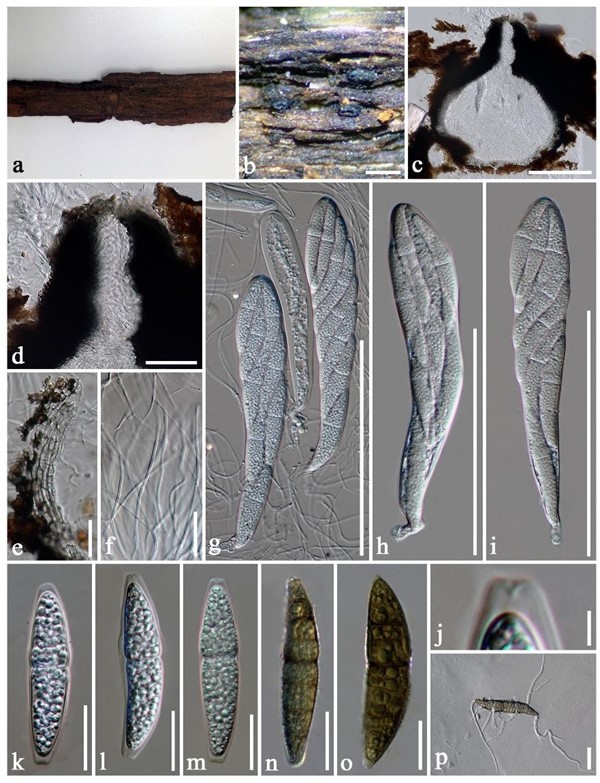Ligninsphaeriopsis thailandica Phukhamsakda, Feng J.F. & K.D. Hyde, sp. nov. Fig. 96
MycoBank number: MB 556784; Index Fungorum number: IF 556784; Facesoffungi number: FoF 08266.
Etymology – Refers to the location where the fungus was collected.
Saprobic on submerged wood in stream habitat. Sexual morph: Ascomata 430–680 × 355– 485 μm (x̅ = 500 × 415 μm, n = 10), on surface of the host, solitary, gregarious, scattered, immersed, only black, elongated, and shiny ostioles part are visible, sub-globose or compressed globose to obpyriform, flattened base, coriaceous, carbonaceous at outer layer and apex, dark brown to black, rough-walled, papillate, ostiolate. Ostiole central, 180–215 × 175–180 μm, with a crest-like apex, elongated and laterally compressed, irregular-walled, black, papillate, opened pore, carbonaceous, ostiolate with periphyses. Peridium 30–60(–105 at apex) μm wide, multilayer, coriaceous to carbonaceous, composed of two strata, an outer stratum thick-walled and black cells arranged in a textura angularis, with carbonaceous, outer layer composed of two layers of dark brown to light brown cells of textura angularis and inner layer of dark brown to black cells of textura angularis, cells towards the inside lighter, with the layers of lightly pigmented, grey brown, inner layer composed of a hyaline gelatinous layer. Hamathecium comprising dense, 1.2–2.5 μm wide (x̅ = 2 μm, n = 50), filiform branches, anastomosing above asci, transverse septate, narowly cellular pseudoparaphyses. Asci 200–350 × 30–50 μm (x̅ = 261 × 35 μm, n = 30), 8-spored, bitunicate, fissitunicate, broad-clavate with tapering to pedicel, apically rounded, ocular chamber clearly visible when immature. Ascospores 70–85 × 15–25 μm (x̅ = 75 × 17 μm, n = 50), 2-seriate or overlapping, broad fusiform, narrow towards the apex, initially hyaline, becoming brown to dark brown at maturity, 6–9 -septate, constricted at the middle septum, with cell above central septum wider, rough-walled, indentations present, with verruculose surface, surrounded by 3–5 μm wide sheath drawn out form polar appendages. Asexual morph: Undetermined.
Culture characteristics – Colonies on MEA reaching 30 mm diam. after four weeks of incubation at 25 °C, from above dark brown radiating outwards, fairy fluffy, dense, circulate in shape, flattened, umbonate, entire edge, fairly fluffy; reverse black at the middle and dark brown at the edges.
Material examined – Thailand, Krabi, Mueang Krabi, soaked in the stream, 1 5 December 2015, C. Phukhamsakda (MFLU 20-0423, holotype); ex-type living culture, MFLUCC 16-0427.
GenBank numbers – ITS: MT676012, LSU: MT676009, SSU: MT676011, rpb-2: MT676008, tef1: MT676007.
Notes – In this study, a fresh collection formed a distinct lineage, close to the type species of Ligninsphaeria, Ligninsphaeria jonesii with moderate support. However, it differs from L. jonesii in having larger asci (206–355 μm vs. 163–243 μm), but smaller ascospores (70–85 μm vs. 79–125 μm). The ascospores of L. jonesii are smooth-walled, indistinctly 1-septate, with a projecting gelatinous cap at both ends, while the new taxon has verrucose, 6–9 -transversely septate ascospores, surrounded by a mucilaginous sheath. Therefore, a new genus Ligninsphaeriopsis is introduced to accommodate Ligninsphaeriopsis thailandica based on morphological evidence coupled with multi-gene phylogenetic results.

Figure 96 – Ligninsphaeriopsis thailandica (MFLU 20-0423, holotype). a Ascomata on submersed wood. b Close up of ascomata. c Section through ascoma. d Ostioles. e Peridium. f Pseudoparaphyses. g–i Asci. j Sheath tip covering ascospore. k–o Ascospores. p Germinating ascospore. Scale bar: b–c, g–i = 200 μm, d = 50 μm, e–f, k–p = 20 μm, j = 5 μm.
